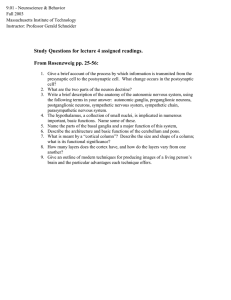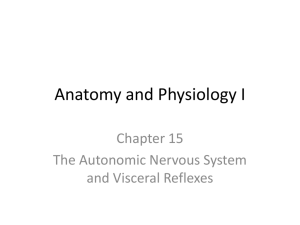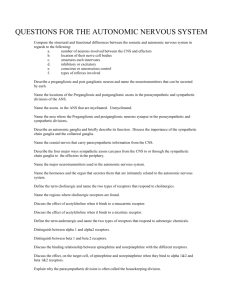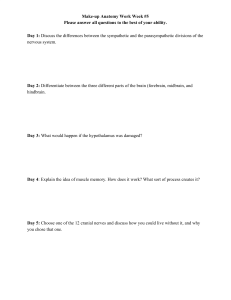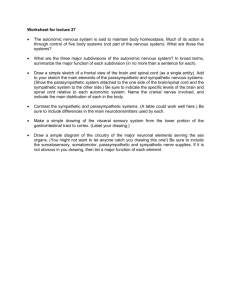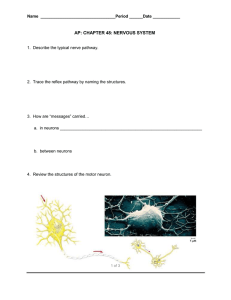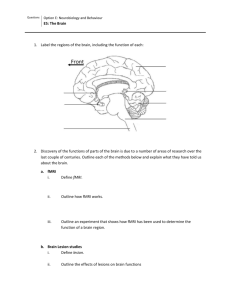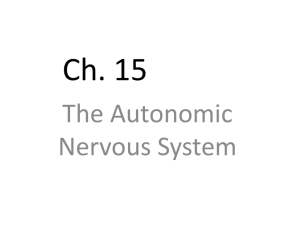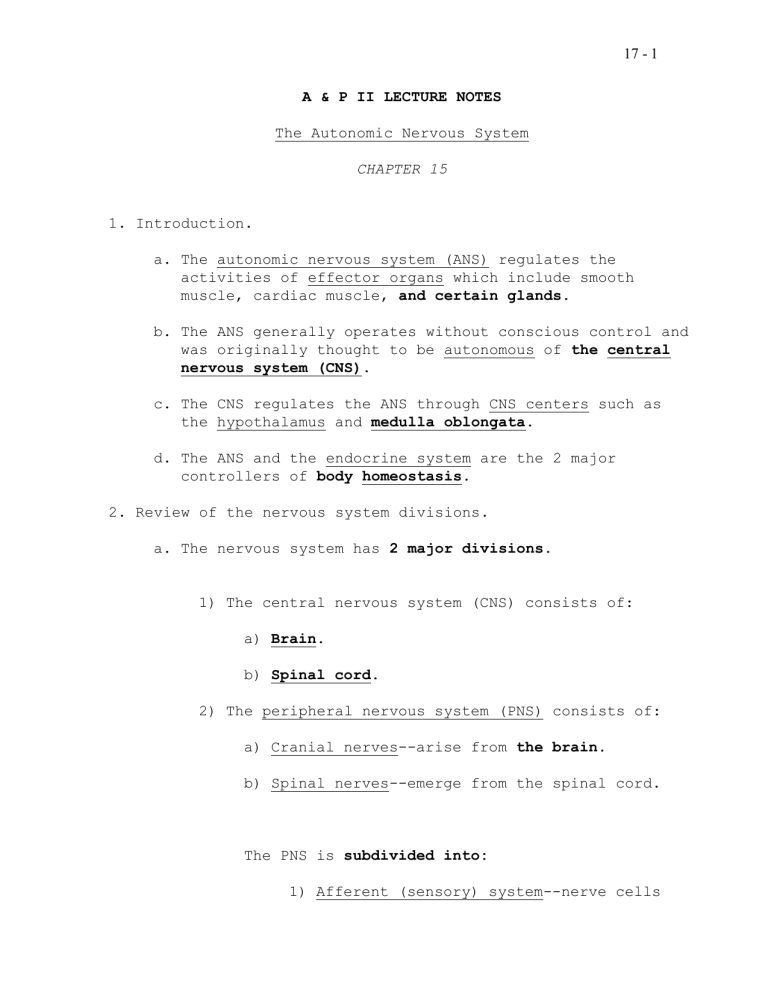
17 - 1 A & P II LECTURE NOTES The Autonomic Nervous System CHAPTER 15 1. Introduction. a. The autonomic nervous system (ANS) regulates the activities of effector organs which include smooth muscle, cardiac muscle, and certain glands. b. The ANS generally operates without conscious control and was originally thought to be autonomous of the central nervous system (CNS). c. The CNS regulates the ANS through CNS centers such as the hypothalamus and medulla oblongata. d. The ANS and the endocrine system are the 2 major controllers of body homeostasis. 2. Review of the nervous system divisions. a. The nervous system has 2 major divisions. 1) The central nervous system (CNS) consists of: a) Brain. b) Spinal cord. 2) The peripheral nervous system (PNS) consists of: a) Cranial nerves--arise from the brain. b) Spinal nerves--emerge from the spinal cord. The PNS is subdivided into: 1) Afferent (sensory) system--nerve cells 17 - 2 that conduct impulses toward the brain. 2) Efferent (motor) system--nerve cells that conduct impulses from the brain to muscles and glands. The afferent and efferent systems are further subdivided into: (a) Somatic nervous system (SNS)— neurons under conscious control that conduct excitation impulses to skeletal muscles only. (b) Autonomic nervous system (ANS)— neurons generally not under conscious control that convey either excitation or inhibition impulses to: (1) Smooth muscle tissue. (2) Cardiac muscle tissue. (3) Glands. (c) The autonomic nervous system is subdivided again into: (1) Sympathetic division--which usually increases an organ's activity. (2) Parasympathetic division— which usually decreases an organ's activity. b. Organs that receive impulses from both sympathetic and parasympathetic nerve fibers are said to have dual innervation. 3. Autonomic motor pathways. a. Sensory neurons of the ANS receive their afferent input from the special senses, general visceral senses, and general somatic senses. b. Autonomic efferent pathways consist of 2 sets of motor 17 - 3 neurons that extend from the CNS, as opposed to 1 motor neuron for the somatic nervous system. 1) The axon of the first ANS motor neuron (preganglionic neuron) is myelinated. a) Its cell body (soma) is located within the gray matter of the brain or the lateral gray horns of the spinal cord. NOTE 1: Gray matter refers to neurons having nonmyelinated nerve axons, as opposed to white matter formed by myelinated axons. NOTE 2: The gray matter of the spinal cord is composed of the anterior gray horns, the lateral gray horns, and the posterior gray horns. b) The preganglionic axon extends from the CNS and synapses in a ganglion with a second neuron (postganglionic neuron). A ganglion is a collection of neuron cell bodies outside the CNS. c) Acetylcholine is the neurotransmitter substance released within the autonomic ganglion formed at the junction of the preganglionic neuron with the postganglionic neuron. 2) The axon of the postganglionic ANS neuron is unmyelinated. a) Its cell body lies entirely outside the CNS in an autonomic ganglion, from which an axon extends peripherally. b) The axon of a postganglionic neuron, the postganglionic fiber, terminates in a visceral effector (end organ). c) Either acetylcholine or epinephrine/norepinephrine 17 - 4 are released at the end organs. Epinephrine and norepinephrine are hormones produced by the adrenal medulla that are collectively termed catecholamines. (1) Epinephrine (adrenalin) stimulates effector organs by causing profound contraction of vascular smooth muscle tissue (vasoconstriction), accelerating heart rate, and relaxation of bronchial smooth muscles (bronchodilation). (2) Norepinephrine (noradrenaline) is similar to epinephrine in causing vasoconstriction, but it has little effect on heart rate or bronchodilation. d) There are 30 times more postganglionic fibers than preganglionic, thus the effects are very widespread. c. Cell bodies (somas). 1) Sympathetic preganglionic somas are located within the lateral gray horns of two spinal cord areas: a) The 12 thoracic segments. b) The first 2 or 3 lumbar segments. c) The sympathetic neuron arrangement is sometimes termed thoracolumbar distribution. 2) Parasympathetic preganglionic somas have two general locations: a) The first location is found in the brain stem nuclei (clusters of CNS neurons) of 4 cranial nerves. (1) CN III (oculomotor)--movement of the iris of the eye. (2) CN VII (facial)--movement of facial 17 - 5 muscles and secretion of tears. (3) CN IX (glossopharyngeal)--taste and saliva secretion. (4) CN X (vagus) (a) Located in the medulla of the brain stem. (b) Associated with the organs of the trunk. (c) Carries about 75-80% of all parasympathetic fibers. b) The second location is found in the lateral gray horns of the second through fourth sacral segments. These cell bodies are associated with the sex organs, urinary system, and rectum. c) The parasympathetic neuron arrangement is sometimes termed craniosacral distribution. d. Autonomic ganglia. 1) There are 3 classifications for ANS ganglia. a) Sympathetic trunk (vertebral chain or paravertebral ganglia)--extends downward on both sides of the spine as 2 chains of linked sympathetic ganglia. b) Collateral (prevertebral) ganglia--anterior to the spinal column and associated with both divisions. c) Terminal (intramural) ganglia--near or inside the visceral effectors of both divisions. 2) The ANS fibers may: 17 - 6 a) Synapse directly with sympathetic trunk ganglia. b) Ascend or descend the sympathetic trunk to reach collateral ganglia. c) Continue directly through the sympathetic trunk to synapse with specific ganglia. Important collateral ganglia are: (1) Sympathetic collateral ganglia--celiac ganglion (solar plexus), superior mesenteric ganglion, and inferior mesenteric ganglion. (2) Parasympathetic collateral ganglia— ciliary ganglion, pterygopalatine ganglion, submandibular ganglion, and otic ganglion. d) Tie in as nets or bundles of nerves associated with specific organ systems. (1) The greater splanchnic nerves are bundles of preganglionic nerve fibers that branch from the 7 lower thoracic segments of the spinal cord. They pass through the sympathetic trunk as a net and converge to synapse on the celiac ganglion. (2) Plexuses are bundles of postganglionic nerve fibers associated with major organs (cardiac plexus, respiratory [pulmonary] plexus, and hypogastric plexus). 4. Actions of the ANS. a. Most body systems receive dual innervation from the sympathetic and parasympathetic divisions. b. Usually one division causes excitation and one causes inhibition. The relationship is paradoxical. 17 - 7 c. The effects of sympathetic stimulation are longer lasting and more widespread than those of parasympathetic stimulation. d. Autonomic neurons are classified on the basis of the neurotransmitter substances they liberate. There are 2 such classifications. 1) Cholinergic neurons release acetylcholine (ACh). They innervate most sweat glands and blood vessels in skeletal muscles. There are 2 types of cholinergic receptors. a) Nicotinic receptors. (1) Found on postganglionic neurons. (2) Innervated by parasympathetic and sympathetic ganglion cells. (3) The effects are short in duration. (4) Produce excitation only. (5) They are so named because nicotine mimics the action of ACh on such receptors. . (6) The drug curare blocks the nicotinic receptors and causes skeletal muscle relaxation (flaccid paralysis). (Succinylcholine/pancuronium) b) Muscarinic receptors. (1) Present at neuroeffector junctions such as sphincter muscles and sweat glands. (2) Innervated by the parasympathetic system only. (3) May produce either excitation or inhibition. 17 - 8 (4) The effects are of long duration. (5) They are so named because muscarine mimics the action of ACh on such receptors. Muscarine is a neurotoxic poison produced by a species of mushroom. (6) The drug atropine blocks the muscarinic receptors and causes pupil dilation, reduced glandular secretions, and relaxation of the lower intestinal tract. 1. Adrenergic neurons release norepinephrine and/or epinephrine. They are found on visceral effectors innervated by most sympathetic postganglionic neurons. There are 2 types of adrenergic receptors. a) Alpha receptors (1) Respond to norepinephrine and epinephrine. 2) React by opening channels that depolarize the cell membrane and cause excitation. (3) Cause constriction of peripheral blood vessels through stimulation of the surrounding smooth muscles. (4) The drug phenylephrine (Entex, Robitussin Night Relief) acts upon alpha receptors by causing vasoconstriction of the nasal mucosa to relieve nasal congestion. b) Beta receptors (1) Especially sensitive to epinephrine. (2) Found in many organs--blood vessels of skeletal muscles, lungs, heart, and liver. (3) They cause increased BP through vasoconstriction. (4) Beta blockers like propranolol (Inderal) 17 - 9 reduce BP by blocking the beta receptors in the heart. f. Sympathomimetic drugs (agonists), promote sympathetic nerve effects, and sympatholytic drugs (antagonists) block sympathetic effects. 1) Phenylephrine is an agonist. 2) Propranolol is an antagonist. g. Parasympathetic and sympathetic responses. 1) The parasympathetic division regulates those activities that conserve and restore body energy. It is an energy conservation-restorative system (rest and digest). (a) The acronym SLUD stands for the primary responses driven by the parasympathetic division. (1) Salivation (2) Lacrimation (3) Urination (4) Defecation (b) Fear may cause a massive activation of the parasympathetic system when there is no avenue of escape. It is sometimes manifested by crying and a loss of control over urination and defecation. 2) The sympathetic division prepares the body for emergency situations. A series of physiological activities called the fight-or-flight response produces the following: a) Epinephrine is released by the adrenal medulla. b) Pupils dilate. 17 - 10 c) Heart rate and BP increase. d) The blood vessels of nonessential organs constrict. e) The blood vessels of essential organs like the heart, skeletal muscles, lungs, and liver dilate. f) The liver splits glycogen into glucose for immediate use by the cells (glycolysis). g) Bronchioles dilate to allow for deeper breathing. 5. Visceral autonomic reflexes. a. A visceral autonomic reflex adjusts the activity of a visceral effector. 1) Examples would be the contraction and relaxation of smooth muscles in the GI tract or changes in the secretions of glands. 2) The homeostasis of heart rate, BP, respiration, digestion, defecation, and urination are visceral autonomic reflexes. b. Visceral sensations do not always reach the cerebral cortex. Most are unconscious, although hunger, nausea, and fullness of the urinary bladder and rectum are conscious expressions of visceral autonomic reflexes. 6. Control by higher centers. a. The hypothalamus controls and integrates the autonomic nervous system. It is connected to both the sympathetic and parasympathetic divisions through centers in the medulla. 1) However, during emotional stress, the cerebral cortex can influence the autonomic nervous system. can increase BP and heart rate. Anxiety 17 - 11 2) Conversely, unpleasant sights can cause vasodilation with a parasympathetic lowering of BP resulting in syncope (fainting). b. Biofeedback is a process in which people learn to monitor visceral functions and to control them consciously. It has been used to control heart rate, alleviate migraine headaches, and facilitate childbirth. 7. Homeostatic Imbalances. a. Achalasia is a dysfunction of the myenteric plexus which innervates the smooth muscles at the lower end of the esophagus. The muscles constrict and prevent food from entering the stomach. Treatment is with a balloon device (bougie tube) that stretches the lower esophageal sphincter (cardiac sphincter). A cardiomyotomy, or cutting of the sphincter muscles, may be required. b. In Horner's syndrome, the sympathetic innervation to one side of the face is lost due to injury or disease (MS). Sweating stops on the affected side (anhidrosis), the pupil becomes markedly constricted (miosis), and the eyelid droops (ptosis). Electrostimulation is sometimes beneficial. Horner's syndrome should not be confused with Bell's palsy, which causes unilateral facial paralysis as a result of somatic motor pathology. (Ptosis, miosis, and anhidrosis.) c. Raynaud's disease often affects young women. Sympathetic stimulation causes excessive peripheral vasoconstriction. The fingers and toes are deprived of blood, become painful, and may become necrotic from lack of oxygen and nutrients. A sympathectomy to cut the sympathetic innervation may provide some relief.

